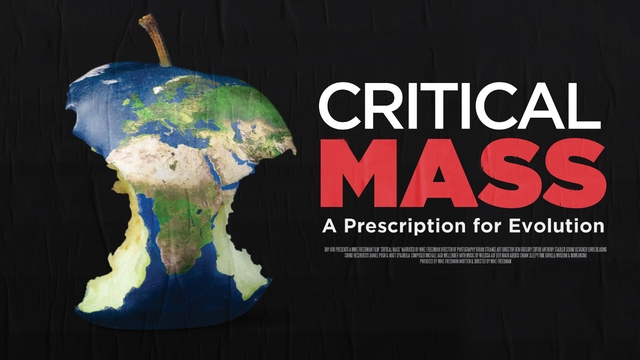Critical Mass
Just how many people can the world support before society breaks?
 Things aren't looking too good for the world's population; as we multiply at an alarming rate there is not enough food, space... or sense. With the planet bursting at the seams the intelligence and physiological traits that make us human are now crucial to mankind's survival. This intelligent film interweaves a fascinating 1960s rat experiment with a slick snapshot of today's urban jungle. As a number of disturbing parallels emerge, you can't help but be affected by this surprising doc.
Things aren't looking too good for the world's population; as we multiply at an alarming rate there is not enough food, space... or sense. With the planet bursting at the seams the intelligence and physiological traits that make us human are now crucial to mankind's survival. This intelligent film interweaves a fascinating 1960s rat experiment with a slick snapshot of today's urban jungle. As a number of disturbing parallels emerge, you can't help but be affected by this surprising doc.


 The ferocity of the attack is horrifying; deep scratches, teeth bite, blood drawn and then the male victim is violently raped. "I shall largely speak of mice, but my thoughts are on man," Dr Calhoun explains, as he sets out the world of a rapidly expanding rat population in a limited space, an analogous situation to that of humans on Earth: "Violence became prevalent... they are highly stressed animals, but the stress comes from each other because of this peculiar violence that they exhibit."
The world of the rats is the frightening prediction that Calhoun has put to us, that as the population grows and the planet becomes more and more crowded, society will start to break down and ultimately end in extinction.
Our society has already had a population density increase by 100,000 times since our original tribal life from which we evolved. What's worse is that we are rapidly accelerating towards the crisis that Calhoun predicted. "147 new people are born every minute. 8850 every hour. 212000 every day. That adds up to 77 million a year." The world's population will hit 9 billion by 2050 (the UN's conservative estimate), but the real worry is that even a slight rise in birth rates could result in 36 billion people on the planet by 2300.
Even more horrifying is that, even aside from the fact that our society is going to tear itself apart and eventually stop reproducing, we can't feed all the people on the planet, let alone the several billion more on their way. "Today, we are using at least 40% more than the Earth can regenerate, so what humanity uses in one year, it takes the biosphere one year and four to five months to regenerate."
But what can we do to avert this coming catastrophe? As Calhoun pointed out, unlike the rats who couldn't stop breeding before hitting the crisis point where their reproduction rate fell to zero, we are able to learn. "You wish to throw your intellectual weight to the optimistic side, to opening up continuing evolution". So apparently it's all down to us now! "The entire future of evolution depends on the next 15 years, it's the people here now, who are involved now."
LEARN MORE.
The ferocity of the attack is horrifying; deep scratches, teeth bite, blood drawn and then the male victim is violently raped. "I shall largely speak of mice, but my thoughts are on man," Dr Calhoun explains, as he sets out the world of a rapidly expanding rat population in a limited space, an analogous situation to that of humans on Earth: "Violence became prevalent... they are highly stressed animals, but the stress comes from each other because of this peculiar violence that they exhibit."
The world of the rats is the frightening prediction that Calhoun has put to us, that as the population grows and the planet becomes more and more crowded, society will start to break down and ultimately end in extinction.
Our society has already had a population density increase by 100,000 times since our original tribal life from which we evolved. What's worse is that we are rapidly accelerating towards the crisis that Calhoun predicted. "147 new people are born every minute. 8850 every hour. 212000 every day. That adds up to 77 million a year." The world's population will hit 9 billion by 2050 (the UN's conservative estimate), but the real worry is that even a slight rise in birth rates could result in 36 billion people on the planet by 2300.
Even more horrifying is that, even aside from the fact that our society is going to tear itself apart and eventually stop reproducing, we can't feed all the people on the planet, let alone the several billion more on their way. "Today, we are using at least 40% more than the Earth can regenerate, so what humanity uses in one year, it takes the biosphere one year and four to five months to regenerate."
But what can we do to avert this coming catastrophe? As Calhoun pointed out, unlike the rats who couldn't stop breeding before hitting the crisis point where their reproduction rate fell to zero, we are able to learn. "You wish to throw your intellectual weight to the optimistic side, to opening up continuing evolution". So apparently it's all down to us now! "The entire future of evolution depends on the next 15 years, it's the people here now, who are involved now."
LEARN MORE.
WATCH MORE.
JOIN THE DISCUSSION.
The Revolution Will Be Improvised - by Director Mike Freedman
 Winner, Outstanding Achievement in Filmmaking, Newport Beach Film Festival, 2013
Winner, Outstanding Achievement in Filmmaking, Newport Beach Film Festival, 2013
 Official Selection, Doxa Vancouver, 2013
Official Selection, Doxa Vancouver, 2013
 Official Selection, Cinemambiente Torino, 2013
Official Selection, Cinemambiente Torino, 2013
 Official Selection, European Film Festival, 2013
Official Selection, European Film Festival, 2013





